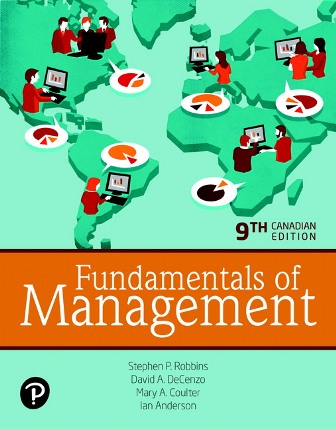Test Bank for Fundamentals of Management, 9th Canadian Edition, Stephen P. Robbins, David A. DeCenzo, Mary A. Coulter, Ian Anderson
$35.00 Original price was: $35.00.$26.50Current price is: $26.50.
Test Bank for Fundamentals of Management, 9th Canadian Edition, Stephen P. Robbins, David A. DeCenzo, Mary A. Coulter, Ian Anderson,
Instant download Test Bank for Fundamentals of Management, 9th Canadian Edition, Stephen P. Robbins, David A. DeCenzo, Mary A. Coulter, Ian Anderson pdf docx epub after payment.
\
Product details:
- ISBN-10 : 0132606925
- ISBN-13 : 978-0132606929
- Author: Stephen P. Robbins, David A. DeCenzo, Mary A. Coulter, Ian Anderson
This brief paperback text gives students more depth and breadth of practical tools to practice their management skills than any other textbook. This edition continues its fresh approach to management coverage through current and relevant examples, updated theory, and a new pedagogically sound design.
Table of contents:
- Chapter 1 Introduction to Management and Organizations
- Learning Objectives
- Why Study Management?
- What Is Management?
- Efficiency and Effectiveness
- Who Are Managers?
- The Organizational Setting
- What Three Characteristics do All Organizations Share?
- How Are Managers Different from Nonmanagerial Employees?
- What Titles Do Managers Have?
- Is the Manager’s Job Universal?
- Level in the Organization
- Profit Versus Not-For-Profit
- Size of Organization
- Management Concepts and National Borders
- What Do Managers Do?
- Four Functions Approach
- Planning
- Organizing
- Leading
- Controlling
- Management Roles Approach
- Functions versus Roles
- Skills and Competencies Approach
- What Factors Are Reshaping and Redefining Management?
- Why Are Customers Important to the Manager’s Job?
- Why Is Innovation Important to the Manager’s Job?
- Importance of Social Media to the Manager’s Job
- Importance of Sustainability to the Manager’s Job
- Chapter Summary
- Learning Objectives Checklist
- Discussion Questions
- Developing Management Skills
- Dilemma
- Becoming a Manager
- Becoming Politically Adept
- Skill Basics
- Diversity Matters
- Hey, You’re the Boss Now!
- Team Exercises
- 3BL: The Triple Bottom Line
- What are the Business Case Benefits of 3BL?
- Thinking Strategically About 3BL
- Be the Consultant
- Business Cases
- Shopify
- Discussion Questions
- Building a Better Boss
- Discussion Questions
- Who Needs a Boss?
- Discussion Questions
- Supplement 1A A Brief History of Management
- Early Management
- Classical Approaches
- Behavioural Approach
- Quantitative Approach
- Contemporary Approaches
- Contemporary Approaches
- Supplement 1B Small and Medium-Sized Enterprises and Organizations
- What Are Small and Medium-Sized Enterprises?
- Key Findings9, 10
- What Are Small and Medium-Sized Organizations?
- Key Findings16
- SMEs and SMOs in Canada: Key Characteristics
- Management in SMEs and SMOs
- Human Resources in SMEs and SMOs
- Financing in SMEs and SMOs
- Innovation in SMEs and SMOs
- Networks and Partnerships in SMEs and SMOs
- Supplement 1C Entrepreneurship1
- What Do Entrepreneurs Do?
- What Planning Do Entrepreneurs Need to Do?
- What’s in a Full Business Plan?
- Executive Summary
- Analysis of Opportunity
- Analysis of the Context
- Description of the Business
- Financial Data and Projections
- Supporting Documentation
- Components of a Good Business Plan
- What Issues Are Involved in Organizing an Entrepreneurial Venture?
- What Are the Legal Forms of Organization for Entrepreneurial Ventures?
- What Type of Organizational Structure Should Entrepreneurial Ventures Use?
- What Human Resource Management (HRM) Issues Do Entrepreneurs Face?
- What Issues Do Entrepreneurs Face in Leading an Entrepreneurial Venture?
- What Type of Personality Do Entrepreneurs Have?
- How Can Entrepreneurs Motivate Employees?
- How Can Entrepreneurs Be Leaders?
- What Controlling Issues Do Entrepreneurs Face?
- How Is Growth Managed?
- How Are Downturns Managed?
- What’s Involved with Exiting the Venture?
- Chapter 2 Environmental Constraints on Managers
- Learning Objectives
- The External Environment
- The Specific Environment
- The General Environment
- Political Conditions
- Economic Conditions
- Sociocultural Conditions
- Technological Conditions
- Environmental Conditions
- Legal Conditions
- Understanding the Global Environment
- PESTEL—Global Environment
- What Does It Mean to Be “Global”?
- What Are the Different Types of Global Organizations?
- How Organizations Go Global
- Importing and Exporting
- Licensing and Franchising
- Strategic Alliance
- Foreign Subsidiary
- Which Is More Important to a Manager: National Culture or Organizational Culture?
- Organizational Culture
- Strong Versus Weak Cultures
- Developing an Organization’s Culture
- How Culture Affects Managers
- How the Environment Affects Managers
- Assessing Environmental Uncertainty
- Chapter Summary
- Learning Objectives Checklist
- Discussion Questions
- Developing Management Skills
- Dilemma
- Becoming a Manager
- Hey, You’re the Boss Now!
- Questions
- 3BL: The Triple Bottom Line
- Can Technology Improve the Way Managers Manage?
- Thinking Strategically About 3BL
- Team Exercises
- Be the Consultant: Understanding Culture
- Assessing Employees’ Global Aptitudes
- Business Cases
- Joe Fresh
- Discussion Questions
- Not Sold Out
- Discussion Questions
- Miovision Technologies Inc. (Internet of Things)
- Discussion Questions
- Chapter 3 Decision Making
- Learning Objectives
- The Decision-Making Process
- What Defines a Decision Problem?
- Step 1: Identify a Problem
- What Is Relevant in the Decision-Making Process?
- Step 2: Identify Decision Criteria
- How Does the Decision Maker Weigh the Criteria and Analyze Alternatives?
- Step 3: Allocate Weights to Criteria
- Step 4: Develop Alternatives
- Step 5: Analyze Alternatives
- What Determines the Best Choice?
- Step 6: Select an Alternative
- Step 7: Implement the Alternative
- Step 8: Evaluate Decision Effectiveness
- Factors Affecting Decision Making
- What Are the Three Approaches Managers Use to Make Decisions?
- 1 Rational Model
- 2 Bounded Rationality
- 3 Intuition and Managerial Decision Making
- Types of Problems and Decisions
- How do Problems Differ?
- Procedures
- Rules
- Policies
- How do Nonprogrammed Decisions Differ from Programmed Decisions?
- Decision-Making Conditions
- Certainty
- Risk
- Uncertainty
- Group Decision Making
- Individual Versus Group Decision Making
- Decision-Making Biases and Errors
- Contemporary Issues in Managerial Decision Making
- How Does National Culture Affect Managers’ Decision Making?
- Why Are Creativity and Design Thinking Important in Decision Making?
- Understanding Creativity
- Understanding Design Thinking
- How Is Big Data Changing the Way Managers Make Decisions?
- Quantitative Decision-Making AIDS
- Ethics, Corporate Social Responsibility, and Decision Making
- Four Views of Ethics
- Improving Ethical Behaviour
- Codes of Ethics and Decision Rules
- Corporate Social Responsibility
- Corporate Social Responsibility and Economic Performance
- Chapter Summary
- Learning Objectives Checklist
- Discussion Questions
- Developing Management Skills
- Dilemma
- Becoming a Manager
- Diversity Matters: The Value of Diversity in Decision Making81
- Team Exercises
- 3BL: The Triple Bottom Line
- Thinking Strategically About 3BL
- Individual Versus Group Decisions
- The Story
- Statements About the Story
- Business Cases
- The Business of Blue Jays Baseball
- Questions
- Coca-Cola and the Science of OJ
- Questions
- Credit Valley Hospital
- Questions
- Chapter 4 Planning and Strategic Management
- Learning Objectives
- What Is Planning and Why Do Managers Need to Plan?
- Planning Defined
- Why Do Managers Plan?
- Planning and Performance
- Criticisms of Planning
- How Do Managers Set Goals and Develop Plans?
- What Types of Goals Do Organizations Have, and How Do They Set Those Goals?
- Characteristics of Well-Designed Goals
- Steps in Goal Setting
- What Types of Plans Do Managers Use and How Do They Develop Those Plans?
- Types of Plans
- Breadth
- Time Frame
- Specificity
- Developing Plans
- Planning Tools and Techniques
- Forecasting
- Contingency Planning
- Scenario Planning
- Benchmarking
- Process Planning
- Organizational Strategy: Choosing a Niche
- Why Is Strategic Management Important?
- The Strategic Management Process
- Step 1: Identify the Organization’s Current Vision, Mission, Goals, and Strategies
- Step 2: Do an Internal Analysis
- Step 3: Do an External Analysis
- Pestel Analysis
- Step 4: Formulate Strategies
- Step 5: Implement Strategies
- Step 6: Evaluate Results
- What Strategies Do Managers Use?
- 1 Corporate Strategy
- 3 main corporate strategies
- 2 Competitive Strategy
- Important Role of Competitive Advantage
- Types of Competitive Strategies
- 3 Functional Strategy
- Social Media as a Strategic Weapon
- Big Data as a Strategic Weapon
- Competitive Strategies
- Chapter Summary
- Learning Objectives Checklist
- Discussion Questions
- Developing Management Skills
- Dilemma
- Becoming a Manager
- Developing Your Interpersonal Skills: Goal Setting for Your Professor
- About the Skill
- Practising the Skill
- Team Exercises
- 3BL: The Triple Bottom Line
- Ethical Competitive Intelligence
- Thinking Critically about Ethical Competitive Intelligence
- Your College or University’s Vision, Mission, and Strategies
- Hey, You’re the Boss Now!
- Business Cases
- SilverBirch Hotels & Resorts
- Prince Edward County
- Questions
- Fast Fashion
- Questions
- Chapter 5 Organizational Structure and Design
- Learning Objectives
- Key Elements in Organizational Structure
- Work Specialization
- Departmentalization
- Chain of Command
- Line and Staff Authority
- How do Authority and Power Differ?
- Span of Control
- Today’s View
- Centralization and Decentralization
- Today’s View
- Formalization
- Today’s View
- What Contingency Variables Affect Structural Choice?
- Mechanistic or Organic17
- Organic organization
- The “If”: Contingency Variables
- 1 Strategy—Structure
- 2 Size—Structure
- 3 Technology—Structure
- 4 Environment—Structure
- Common Organizational Designs
- Traditional Organizational Designs
- Simple Structure
- Functional Structure
- Divisional Structure
- Contemporary Organizational Designs
- Team Structure
- Matrix and Project Structures
- Boundaryless Organizations
- Virtual Organizations
- Network Organizations
- Contemporary Organizational Design Challenges
- Designing Office Space
- Keeping Employees Connected
- Building a Learning Organization
- Integrating Sustainability into the Organizational Structure
- 3BL: The Triple Bottom Line
- Thinking Strategically About 3BL
- Managing Global Structural Issues
- Designing Efficient and Effective Flexible Work Arrangements
- What’s Involved in Telecommuting?
- How Can Organizations Use Compressed Workweeks, Flextime, and Job Sharing?
- What is a Contingent Workforce?
- Chapter Summary
- Learning Objectives Checklist
- Discussion Questions
- Developing Management Skills
- Dilemma
- Becoming a Manager
- Diversity Matters
- Team Exercises
- Be the Consultant: The Nova Scotia Association of Social Workers
- Business Cases
- Pfizer: A New Kind of Structure
- Questions
- Levitt-Safety Limited
- Questions
- You Work Where?
- Discussion Questions
- Chapter 6 Human Resource Management
- Learning Objectives
- The Human Resource Management Process
- Environmental Factors Affecting HRM
- Organizational Culture
- Economic Conditions
- Labour-Market Issues
- Government Legislation
- Technology
- Planning Human Resource Needs
- (1) How Does an Organization Do a Current HR Assessment?
- (2) How Are Future Employee Needs Determined?
- (3) Balancing Supply and Demand
People also search:
Fundamentals of Management, 9th Canadian Edition
Fundamentals of Management, 9th Canadian Edition pdf
Fundamentals of Management
fundamentals of management and organisational behaviour
fundamentals of management and organizational behavior
what are the fundamentals of project management
Related products
Test Bank
Test Bank for Essentials of Business Law and the Legal Environment, 11th Edition: Richard A. Mann











